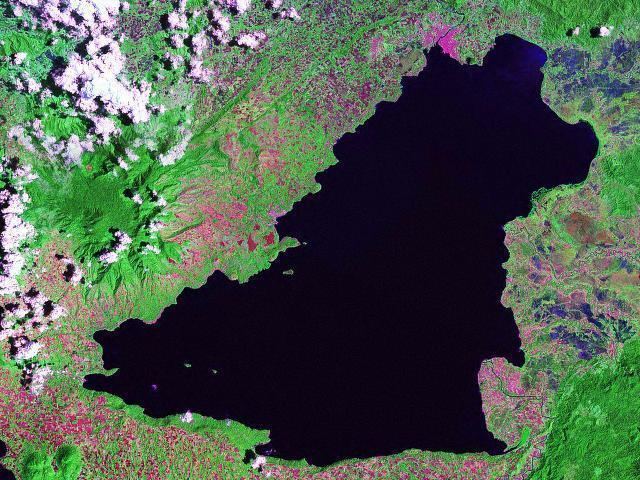Primary inflows Area 340 km² Width 20 km | Primary outflows Agus River Max. length 33 km (21 mi) Surface elevation 700 m Mean depth 60 m | |
 | ||
Cities Marawi, Ditsaan-Ramain, Masiu, Binidayan | ||
Dragons in lake lanao
Lake Lanao (Maranao: Ranao or Ranaw) is a large lake in the Philippines, located in Lanao del Sur province in the country's southern island of Mindanao. With a surface area of 340 km2 (130 sq mi), it is the largest lake in Mindanao, and the second largest lake in the Philippines and counted as one of the 15 ancient lakes in the world.
Contents
- Dragons in lake lanao
- Map of Lake Lanao Lanao del Sur Philippines
- Lake lanao time lapse
- Physical characteristics
- Biodiversity
- In culture
- References
Map of Lake Lanao, Lanao del Sur, Philippines
Lake lanao time lapse
Physical characteristics
The lake was formed by the tectonic-volcanic damming of a basin between two mountain ranges and the collapse of a large volcano. It has a maximum depth of 122 m (400 ft), and a mean depth of 60.3 m (198 ft). The basin is shallowest towards the north and gets progressively deeper towards the south.
The lake is fed by four rivers. Its only outlet is the Agus River, which flows northwest into Iligan Bay via two channels, one over the Maria Cristina Falls and the other over the Linamon Falls. A hydroelectric plant installed on the Lanao Lake and Agus River system generates 70% of the electricity used by the people of Mindanao.
The lake is a home of myths and legends of the Meranaw tribe. The name Meranaw was derived from the name of the lake and it means "the people living around the lake".
Biodiversity
Lake Lanao was proclaimed as a watershed reservation in 1992 through Presidential Proclamation 971 to ensure protection of forest cover and water yield for hydropower, irrigation and domestic use.
The lake is (or was) home to 18 endemic species of cyprinid fish in the genus Barbodes (most were formerly in Puntius). It also supports a large number of waterfowl. An investigations in 1992 only managed to locate three of the endemic fish species, and only two (Barbodes lindog and B. tumba) were located in 2008. It is believed that overfishing, pollution and competition from introduced species caused the extinction of the remaining. In October 2006, a study from the Mindanao State University discovered massive algae contamination in Lake Lanao. Initially, poor sewage and agricultural waste management were seen as the culprit to the contamination. However, the Department of Agriculture and the Bureau of Fisheries and Aquatic Resources stated that soil erosion from indiscriminate logging and extensive land use and farming are the problems that caused the algae contamination. Around 42 endemic crab species can also be found in Lake Lanao.
The 18 endemic cyprinid species of Lake Lanao:
Notes: (*) - Biggest native species in Lake Lanao (**) - Species of high commercial value
In culture
A Maranao myth describes the formation of the lake. It is said that a group of angels under the command of Gabriel removed the vast population of Mantapoli to prevent the world from tipping over. The hole that was left was filled with water and threatened to drown the rest of the world. In response, the angels enlisted the help of the Four Winds to gouge out an outlet. The hole became Lake Lanao and the outlet became the Agus river. A Meranaw is a spoken or language of Maranao people.
